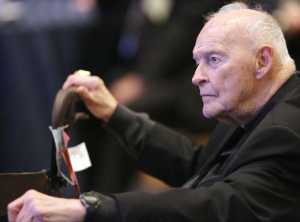A historic development today in the fight against sexual abuse in the Church: a cardinal, albeit a retired one, resigned his title and red hat, and was ordered to cease all his public duties and lead a live of prayer and penance in a yet to be announced location.
 Cardinal – now just Archbishop – Theodore McCarrick faces two allegations of sexual abuse of minors and several further claims of harassment of and misconduct with adults. The steps taken today come before his case is heard and judged in a canonical trial according to ecclesiastical law, and any legal developments which may take place in an American court of law, as the law allows (the major obstacle in such cases, which – as here – often took place many years ago, remains the statute of limitations).
Cardinal – now just Archbishop – Theodore McCarrick faces two allegations of sexual abuse of minors and several further claims of harassment of and misconduct with adults. The steps taken today come before his case is heard and judged in a canonical trial according to ecclesiastical law, and any legal developments which may take place in an American court of law, as the law allows (the major obstacle in such cases, which – as here – often took place many years ago, remains the statute of limitations).
The case of McCarrick brings back strong memories of that of the late Scottish Cardinal O’Brien. He too saw all his cardinal rights and duties removed on his own request, but he was allowed to remain a cardinal. Former Cardinal McCarrick is punished more severely, although it is, in some ways, a passive punishment, as it was McCarrick himself who requested it in a letter to the Pope.
The full resignation of a cardinal is a rare event, and this is the first time it has happened since 1927. In 2015, I wrote a blog post about the history of cardinal resignations, in which I gave an overview of past resignations of cardinals (although in it I erroneously claimed that the last such resignation took place in 1911 instead of 1927).
It remains to be seen if there will be a canonical trial for McCarrick, as today’s press release suggests, and if so, what its result will be. Perhaps there will be further penalties for Archbishop McCarrick. On Twitter, Dr Kurt Martens, Professor of Canon Law at the Catholic University of America, offers a detailed analysis of the possible penalties that can be levied against McCarrick according to the laws of the Church. He suggests that dismissal from the clerical state is one of the few options remaining, as McCarrick is already retired and so no longer holds any office. Martens mentions two recent examples of prelates having been laicised after allegations of abuse: Raymond Lahey, former bishop of Antigonish in Canada in 2012, and Józef Wesolowski, former Apostolic Nuncio to the Dominican Republic (and thus automatically an archbishop) in 2014.
Beyond McCarrick, there is a chance that there will be consequences for other bishops in the United States and Rome, as the question of who knew what and when about McCarrick’s abuse remains unanswered.
Theodore Edgar McCarrick was a priest of the Archdiocese of New York, and became auxiliary bishop of that archdiocese in 1977. In 1981, he was appointed as bishop of Metuchen in New Jersey, and then as archbishop of Newark in 1986. From 2011 to 2006 he served as archbishop of Washington. He was created a cardinal in the giant consistory of 21 February 2001 (making him a cardinal class mate of Pope Francis). He held the title of Santi Nereo ed Achilleo. The two allegations of sexual abuse of a minor, which were deemed credible and substantiated by the Archdiocese of New York in June, took place in the early 1970s and involved a then 16-year-old boy. McCarrick was then serving as a priest in New York, and today claims to have no memory of the alleged abuse. At the same time last month, the chanceries of the Archdiocese of Newark and the Diocese of Metuchen, where McCarrick served as bishop, announced that they had received three further allegations of misconduct involving adults, and that two of these allegations had resulted in settlements.
Photo credit: CNS photo/Bob Roller
 The current holder of the youth portfolio, as well as his predecessor, in the Dutch Bishops’ Conference have, as expected, been chosen as delegate and substitute to October’s Synod of Bishops on youth and vocation. Bishop Rob Mutsaerts, auxiliary bishop of ‘s-Hertogenbosch, was chosen by his fellow bishops in the spring, and the Synod secretariat has now confirmed it. That confirmation also means that we may soon see a first list of delegates, although, it being summer, the publication could also take a few more weeks. One name on that list will be that of the Belgian delegate, Bishop Jean Kockerols, auxiliary bishop of Mechelen-Brussels and former vice-president of COMECE.
The current holder of the youth portfolio, as well as his predecessor, in the Dutch Bishops’ Conference have, as expected, been chosen as delegate and substitute to October’s Synod of Bishops on youth and vocation. Bishop Rob Mutsaerts, auxiliary bishop of ‘s-Hertogenbosch, was chosen by his fellow bishops in the spring, and the Synod secretariat has now confirmed it. That confirmation also means that we may soon see a first list of delegates, although, it being summer, the publication could also take a few more weeks. One name on that list will be that of the Belgian delegate, Bishop Jean Kockerols, auxiliary bishop of Mechelen-Brussels and former vice-president of COMECE.
